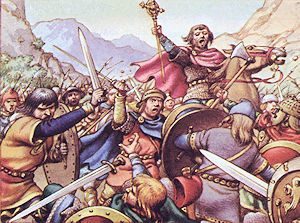St Germanus
Those readers who were unfortunate enough to see the 2005 Antoine Fuqua film King Arthur might think they have seen a glimpse of the real St Germanus in the guise of the character “Bishop Germanius”. In this wretched movie, Germanius (like the real Germanus) is an opponent of Pelagianism which is presented as a form of political democracy (which it most assuredly was not). He, like all other Christians in the film, is a Bad Guy. The real Germanus was much more interesting than this cartoon villain.
Germanus, also known as St. Germain, (380-448) was born into a wealthy and well-connected family at the time of the collapse of the Roman Empire in the West. As a brilliant lawyer he came to the attention of the imperial court and was named a Duke (a post combining military and administrative responsibilities) in charge of provinces in Gaul. He was based at Auxerre in what is now central France and would have dealt with the invading Germanic barbarians as well as trying to keep civilization going in a time of chaos. Like many Roman administrators of the time he left the civil service and joined the Church where he was made bishop of Auxerre. Around 429 he was sent across the Channel into Britain, a province abandoned by the Roman army and beset by raiders from all sides. The island was also the home of the dangerous Pelagian heresy which denied Original Sin and insisted on the ability of the free human will to perfect itself. Germanus was sent to Britain to confront the supporters of this idea and reassert orthodoxy, which he seems to have done successfully. A 20th-century poem by Hilaire Belloc says:
And then with his stout Episcopal staff
So thoroughly whacked and banged
The heretics all, both short and tall,
They rather had been hanged.
While in Britain he learned of a combined attack by northern tribes known as Picts, and German raiders. He led an ambush of the invaders known as the “Alleluia Victory” after the Christian battle cry. Germanus also seems to have played a role in the establishment of the cult of St Alban, British Christianity’s first martyr. Back in Gaul he continued his battles against barbarians. He died at Ravenna, the imperial capital where he had gone to try and convince the worthless emperor Honorius to call off his barbarian mercenaries, but he is buried in Auxerre where his relics were venerated until his tomb was destroyed by Protestants in the 16th century.
